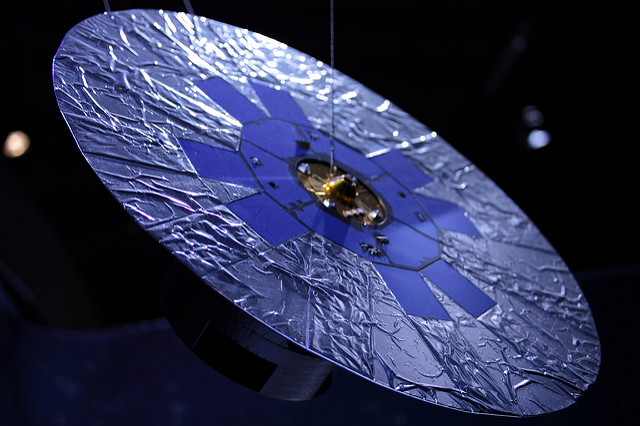Making Gaia
Interview with
If you want to get a census of our galaxy, how do you go about it? The Gaia  spacecraft itself is nestling in a region of space called the L2 lagrange point, where it sits in the Earth's shadow, sheltered from the glare of the sun. But what's on board, and how does it work? Georgia Mills took a trip to meet Gaia's makers...
spacecraft itself is nestling in a region of space called the L2 lagrange point, where it sits in the Earth's shadow, sheltered from the glare of the sun. But what's on board, and how does it work? Georgia Mills took a trip to meet Gaia's makers...
Ralph - I'm Dr Ralph Cordey and I'm head of science here at AirBus Defence and Space at Stevenage.
Georgia - So we're sitting here in your office looking at a frisbee. So this is Gaia, this is the spacecraft that's out there gathering data at the moment. It's about the size of a frisbee and a small very thin circle with a kind of upside down cup stuck in the middle and it says here this is about one to fifty scale, so the real thing is fifty times bigger?
Ralph - Yes, the real thing is about four metres across; it's a big disc and that disc has a particular purpose. It basically sits on the backside of the spacecraft, pointing towards the Earth to protect the spacecraft from the heat of the Sun. It's about stability; all of this mission is about stability and protecting it in a really stable thermal environment is one of the key aspects of this.
Georgia - So what kind of tech is on board, I suppose?
Ralph - Basically, Gaia is a telescope. Or really it's two telescopes looking in two directions at once and not just measuring the directions to stars that it sees but looking at the relative directions between different patches of the sky.
Now, Gaia rotates about once every six hours, sweeping out a path with its telescopes across the sky and measuring, as it does so, the positions of stars and over its five year operational lifetime it's going to be measuring each star about seventy times. That allows it build up an intricate web of positions and, as a result of that, it can ultimately measure the position of a star to the equivalent accuracy of measuring the thickness of a human hair at a distance of about one thousand kilometers. It is absolutely phenomenal the accuracy that it can measure to. It's actually so sensitive that it's picking up the distortions in the direction of light caused by general relativity in the solar system. So it's distortions to space and time it's actually responding to as well.
Georgia - So how on earth is it getting an image this clear - what did you say, a human hair thousands of kilometers away?
Ralph - It's doing it by first of all having quite large telescopes but, importantly, it's about its stability. It's thermally stable so that it's not expanding or contracting so that we can control the telescope very accurately like that, but it's also pointing very accurately as it spins.
In its environment it has to put up with micrometeoroids, flecks of dust and things which will impact it at high velocity and actually change its rotation rate. It's got to be able to deal with those and maintain its rotation and keep on going. Now to do that it's not using rockets or anything like that; it's using little jets of cold gas, of nitrogen, little puffs. The spacecraft itself weighs a couple of tons so little puffs of nitrogen are an incredibly fine way of tuning the rotations rate of this spacecraft.
So that, combined with its stability, gives you this incredible accuracy that builds up over that five year mission.
Georgia - How can Gaia tell how far away a star is?
Ralph - The basic technique is one called parallax. Now parallax is about the difference in direction that a star appears to be from different positions you observe it in. Now you can measure parallax just by standing in different positions one side of a city to another, but that won't be very good if your star is many, many light years away, or from side of the Earth to the other, or as we're doing it with Gaia. Gaia is following the Earth around its orbit so, actually, it's looking at these stars from one side of Earth's orbit to the other side of Earth's orbit and that gives it a very nice baseline to look at the difference in directions to those stars and helps us to pin them down in three dimensions.
Georgia - I see, so because Gaia knows how far it has moved, the relative amount the star has moved will give an idea of how far away it is?
Ralph - I mean if you want a simple example, put your finger in front of you against a background, look at it with one eye shut, and then look at it with the other eye shut and you'll see it appear against that background in different apparent positions. And that's what we're doing except that what we're doing it with are stars which are many tens, to hundreds, to thousands of light years away.
- Previous Gaia part 1
- Next A deluge of data










Comments
Add a comment